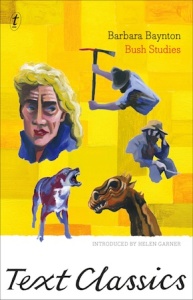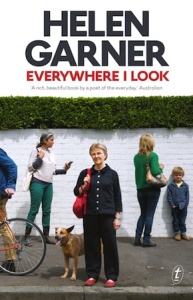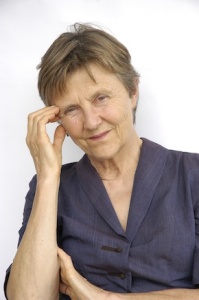Gall and barefaced daring
by Helen Garner I was well into my forties when I came upon Barbara Baynton’s story ‘The Chosen Vessel’, and I have never got over it. It is shocking, and dreadful: a lone woman huddles with a tiny baby in an undefendable bush house at night, while a tramp armed with a knife slinks around it in the dark, seeking a way in. The terror Baynton evokes is elemental, sexual, unabashedly female in a way one hardly expects to read in literature of her time. Under the title ‘The Tramp’, the story appeared in the Bulletin in 1896. It was the first she ever published. She was thirty-nine.
I was well into my forties when I came upon Barbara Baynton’s story ‘The Chosen Vessel’, and I have never got over it. It is shocking, and dreadful: a lone woman huddles with a tiny baby in an undefendable bush house at night, while a tramp armed with a knife slinks around it in the dark, seeking a way in. The terror Baynton evokes is elemental, sexual, unabashedly female in a way one hardly expects to read in literature of her time. Under the title ‘The Tramp’, the story appeared in the Bulletin in 1896. It was the first she ever published. She was thirty-nine.
A century later, I wrote an essay about a winter night I had spent alone in a shack on the edge of a forest. A male writer I showed it to was irritated by my anxious fantasies of marauding men, and by the mental manoeuvres I had had to perform in order to calm myself for sleep. I suppose he saw it as a piece of crude feminism. I have never got over this, either; and whenever I re-read ‘The Chosen Vessel’ I experience a deep solidarity with both its main character and its writer.
Baynton’s best-known story is probably ‘Squeaker’s Mate’. Here the bush woman is stripped of every vestige of femininity. She is childless, even ‘barren’ – a tough, skilled timber-getter who smokes a pipe and always carries ‘the heavy end of the log’. Somehow this tireless worker has taken up with Squeaker, a bloke whom even the other men recognise as a whingeing bludger: to them, “her tolerance was one of the mysteries”. A falling tree terribly wounds her. The story is an account of a power struggle between the feckless man and the silent, devastated woman whom he leaves to lie in a corner of their shack, attended only by her dog. Every time I read it I am astonished by Baynton’s gall, the barefaced daring of the thing. It’s driven by a contained, contemptuous rage that no woman of spirit can fail to recognise, or to share.
Weakened by her absent husband’s cold mockery, she is not fighting for her family. No bushcraft, no weary stoicism can save her from sexual attack. She is lost out there in shrieking, existential abandonment.”
Baynton was born a decade before Henry Lawson, but by the time she began to publish he was already a famous writer. Determined as she was to write from deep within a woman’s point of view, in her best work she can leave him sounding almost sentimental. Yes, Lawson’s ‘The Drover’s Wife’ is a great story. We fear for the hardworking, faithful, level-headed mother. We shed tears for her gutsy little son, for the brave dog, for the ‘sickly daylight’ that breaks over the bush. The story is what people nowadays call ‘iconic’. We can safely admire it. We no longer even need to read it: everyone knows what it stands for.
But Baynton’s bush wife inhabits a different universe. Weakened by her absent husband’s cold mockery, she is not fighting for her family. No bushcraft, no weary stoicism can save her from sexual attack. She is lost out there in shrieking, existential abandonment. Her tale is never going to be an icon. It is too hair-raising, too hysterical – too close to women’s craziest and most abject suffering.
Like any writer, she is not always at her best. Her sentences can strike the modern ear as clogged and heavy-handed, like Victorian interior decoration. You can feel her sometimes putting on side, striking writerly poses, indulging in misty poeticisms: betimes, she says, or ’twas a dingo; her heart smote her, or ever and ever she smiled. Her desire to convey Australian speech leads her into passages of dialogue so manically phonetic that the only way to traverse them is to read them aloud, when they reveal her superb ear – but at what cost! I long to take the pencil to these extravaganzas, to drag her into my own century and hit her over the head with Elmore Leonard’s dictum: “If it sounds like writing, I rewrite it.”
But, my God, when she hits her straps she can lay down a muscular story.
She drew out the saw, spat on her hands, and with the axe began weakening the inclining side of the tree.
Long and steadily and in secret the worm had been busy in the heart. Suddenly the axe blade sank softly, the tree’s wounded edges closed on it like a vice. There was a ‘settling’ quiver on its top branches, which the woman heard and understood. The man, encouraged by the sounds of the axe, had returned with an armful of sticks for the billy. He shouted gleefully, ‘It’s fallin’, look out.’
But she waited to free the axe.
With a shivering groan the tree fell, and as she sprang aside, a thick worm-eaten branch snapped at a joint and silently she went down under it.
(‘Squeaker’s Mate’)
At their height, her dry, sinewy sentences stride forward powered by simple verbs. She knows how to break off at a breathless moment. She is familiar with labour, fear and abandonment. Her rendering of dogs and their meaning is very fine. She knows the landscape, with its bleak terrors and its occasional beauties. She has observed with a merciless eye the dull stupidity and squalor that poverty brings. She is not going to gussy it up.
Between Two Worlds, the enthralling biography of Baynton written by her great-granddaughter the late Penne Hackforth-Jones, makes it clear that the six stories in Bush Studies, the core of her small output, draw directly on the first half of her life.
She was born Barbara Lawrence in 1857, the seventh of eight children, at Scone in the Hunter Valley of New South Wales, where her immigrant father was a timber worker and coffin-maker. She seems to have been a strange, short-sighted, grittily emotional girl, a passionate reader of the few books she could get hold of, and possessed by confused fantasies of escape and adventure.
As a teenager she answered an advertisement for an up-country housekeeper. After a gruelling train trip to the property on the northwestern plains of New South Wales, the naïve girl was coarsely challenged, humiliated and sent packing. A few years later, in her early twenties, with little more than her hard-won literacy and numeracy to recommend her, she was hired as a governess by the Fraters, a Scottish grazing family of impressive style but varying fortunes, whose glamorous son she soon married.
The theme of a weakened and dependent person alone at night in a flimsy bush dwelling, which occurs again and again in Baynton’s work, surely originates in her own first marriage.”
Set up by his disapproving father near Coonamble on the Castlereagh River, the handsome horseman Alex Frater soon showed his true colours. He drank, he gambled, he flirted with girls fresher and prettier than his clever, overworked, furious wife. The property slid into disarray while he went off droving and boozing for months at a time, leaving her and their babies without protection. The theme of a weakened and dependent person alone at night in a flimsy bush dwelling, which occurs again and again in Baynton’s work, surely originates here.
By the time Frater had seduced and impregnated Barbara’s young niece Sarah, who had come to help her with the children, the iron had entered Barbara’s soul. In 1889 she blasted her way out of the marriage, keeping custody of their three children. Her divorce, according to Hackforth-Jones, was “the four-hundred-and-fifty-first of the colony”. Throughout her life Barbara liked to deliver a terse piece of advice to her daughter Penelope: “If you make yourself a doormat, don’t be surprised if you’re walked on.”
 Poor Sarah’s fate enacted this bitter wisdom. She toiled on in wretched poverty, bearing more and more children to the ever-unreliable Frater, until soon after the birth of the ninth she fell into despair, and died in a Sydney mental hospital.
Poor Sarah’s fate enacted this bitter wisdom. She toiled on in wretched poverty, bearing more and more children to the ever-unreliable Frater, until soon after the birth of the ninth she fell into despair, and died in a Sydney mental hospital.
Meanwhile, Barbara shook the dust of the bush from her feet and lit out for Sydney. She was engaged as a housekeeper in pleasant Woollahra by the respected Dr Thomas Baynton, a widower more than twice her age. Barbara had learnt from her former mother-in-law how to conduct herself among educated people. Within a year, and the day after her divorce from Frater was finalised, she and the doctor were married.
Though only in her early thirties, she had experienced enough affront, desolation and rage to fuel a lifetime’s literary output. Now, sharing an orderly urban life with a man she loved and respected, she could begin to write.
It irked her that some of her contemporaries were starting to romanticise, or to present in comic form, what she knew as the grinding slog and suffering of people who worked the land. She would make it her business to show the truth.
No one in Australia would publish Bush Studies, so she took it to London, where she met the usual insults dealt out to colonials; she even contemplated burning the manuscript and going home. But at last, in 1902, the book appeared in both London and Sydney. A.G. Stephens, who had first run her work in the Bulletin, opined ludicrously that the stories offered “a perverse picture of our sunny, light-hearted, careless land”; but Baynton had many admiring reviews, and felt at last established.
Nothing else she published packs the raw punch of Bush Studies. Her natural form is the short story. Her novel Human Toll contains powerful and sensitive passages, but her obsession with phonetic dialogue is frustrating and fatiguing. One forgets her poetry with relief.
But what a woman! When her dear Dr Baynton died, she inherited and sensibly invested a comfortable fortune. In London during World War I she was a generous host to many a lost Australian serviceman on leave. She fought her way up the social ladder in the most audacious way. Her third husband was a baron who had converted to Islam. He was offered the vacant throne of Albania. To Barbara’s great disappointment he refused it. The marriage lasted barely a year.
By now, though certain good friends never gave up on her, she seemed stuck in the role of the perverse dowager in jewels and long white gloves, known for her jealousy, bursts of wild rage and equally violent remorse. She returned to Melbourne and took up residence next door to her daughter, whose husband had the sense of humour and strength of character to keep the matriarch in line. Her grandchildren she thrilled by writing and reading aloud to them cautionary tales “of human unpleasantness and folly”. These stories were never published, and when at the age of seventy-two the champagne-drinking old termagant died, her faithful daughter, who loved her, threw them into the fire.
From the collection Everywhere I Look, written as the introduction to the 2012 edition of Barbara Baynton’s Bush Tales, both published by Text Publishing
 Helen Garner writes novels, stories, screenplays and works of non-fiction. She lives in Melbourne. In 2006 she received the inaugural Melbourne Prize for Literature, and in 2016 she won the prestigious Windham-Campbell Prize for non-fiction and the Western Australian Premier’s Book Award. Her essay collection Everywhere I Look, out now from Text Publishing, won the 2017 Indie Book Award for Non-Fiction.
Helen Garner writes novels, stories, screenplays and works of non-fiction. She lives in Melbourne. In 2006 she received the inaugural Melbourne Prize for Literature, and in 2016 she won the prestigious Windham-Campbell Prize for non-fiction and the Western Australian Premier’s Book Award. Her essay collection Everywhere I Look, out now from Text Publishing, won the 2017 Indie Book Award for Non-Fiction.
Read more
Author portrait © Nicholas Purcell

